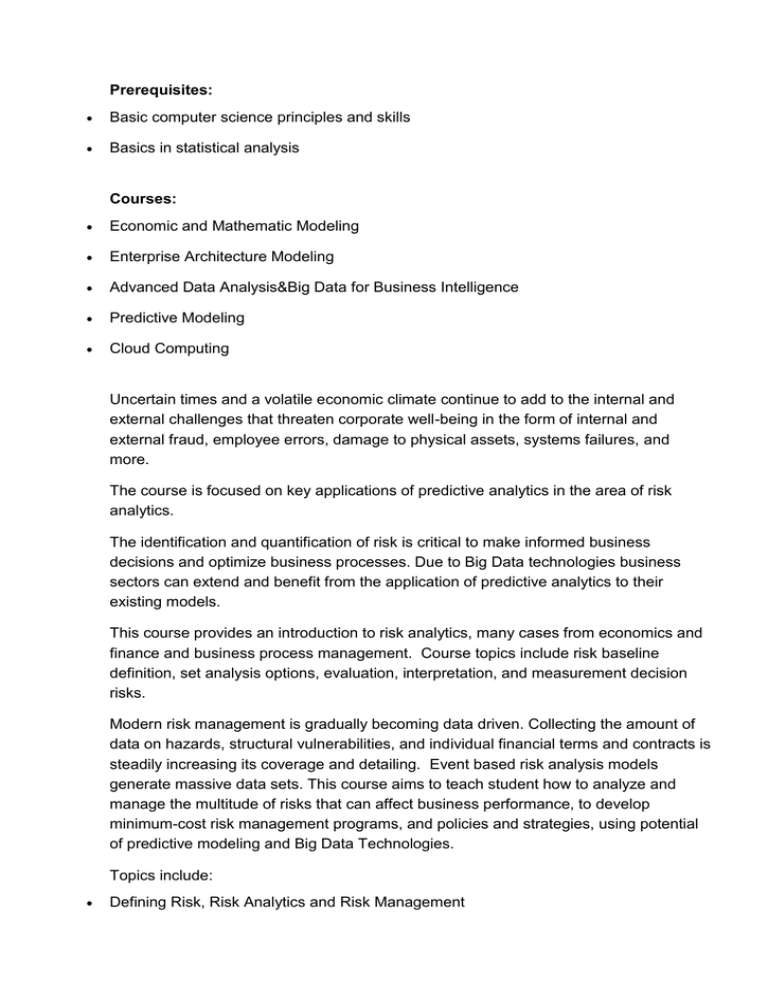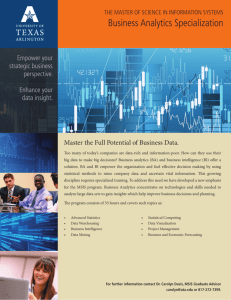Programme
advertisement

Prerequisites: Basic computer science principles and skills Basics in statistical analysis Courses: Economic and Mathematic Modeling Enterprise Architecture Modeling Advanced Data Analysis&Big Data for Business Intelligence Predictive Modeling Cloud Computing Uncertain times and a volatile economic climate continue to add to the internal and external challenges that threaten corporate well-being in the form of internal and external fraud, employee errors, damage to physical assets, systems failures, and more. The course is focused on key applications of predictive analytics in the area of risk analytics. The identification and quantification of risk is critical to make informed business decisions and optimize business processes. Due to Big Data technologies business sectors can extend and benefit from the application of predictive analytics to their existing models. This course provides an introduction to risk analytics, many cases from economics and finance and business process management. Course topics include risk baseline definition, set analysis options, evaluation, interpretation, and measurement decision risks. Modern risk management is gradually becoming data driven. Collecting the amount of data on hazards, structural vulnerabilities, and individual financial terms and contracts is steadily increasing its coverage and detailing. Еvent based risk analysis models generate massive data sets. This course aims to teach student how to analyze and manage the multitude of risks that can affect business performance, to develop minimum-cost risk management programs, and policies and strategies, using potential of predictive modeling and Big Data Technologies. Topics include: Defining Risk, Risk Analytics and Risk Management Frequency vs. impact, expected vs. unexpected losses Operational risk categorization, organizational modeling and frameworks Inherent and residual risks, causal and secondary risks Building a risk structure – risks, events and controls The Basel II Accord. Basic Indicator Approach. Standardised Approach. Advanced Measurement Approach (AMA) Basel III changes: Impact on operational risk management and future directions Operational risk measurement and OpVaR The IMA, LDA and Scorecard methods The ORM Process Summary. Identification, assessment, measurement, mitigation/control and monitoring and reporting RCSA approaches Stress testing and scenario analysis COSO and ISO 31000 Fault Tree Analysis (FTA) HAZOP (Hazard and Operability) FMECA (Failure Modes Effects Criticality Analysis) Event Tree Analysis Modeling the Operational Loss Generation Process Monte Carlo simulation models Risk Analytics on Cloud Infrastructure Effective use in risk analysis Big Data techniques, developed in the context of webscale analytics Aggregation-based Big Data approaches to the risk analytics Hardware and software architectures to support Big Data risk analytics Data warehouse structure for implementation of Big Data based risk analytics 1. Michael Minelli, Michele Chambers, Ambiga Dhiraj . Big Data, Big Analytics: Emerging Business Intelligence and Analytic Trends for Today's Businesses. Wiley, 1 edition, 2013 2. Eric Siegel, Thomas H. Davenport. Predictive Analytics: The Power to Predict Who Will Click, Buy, Lie, or Die. Wiley; 1 edition, 2013 3. David Vose. Risk Analysis: A Quantitative Guide. John Wiley & Sons, 2008







